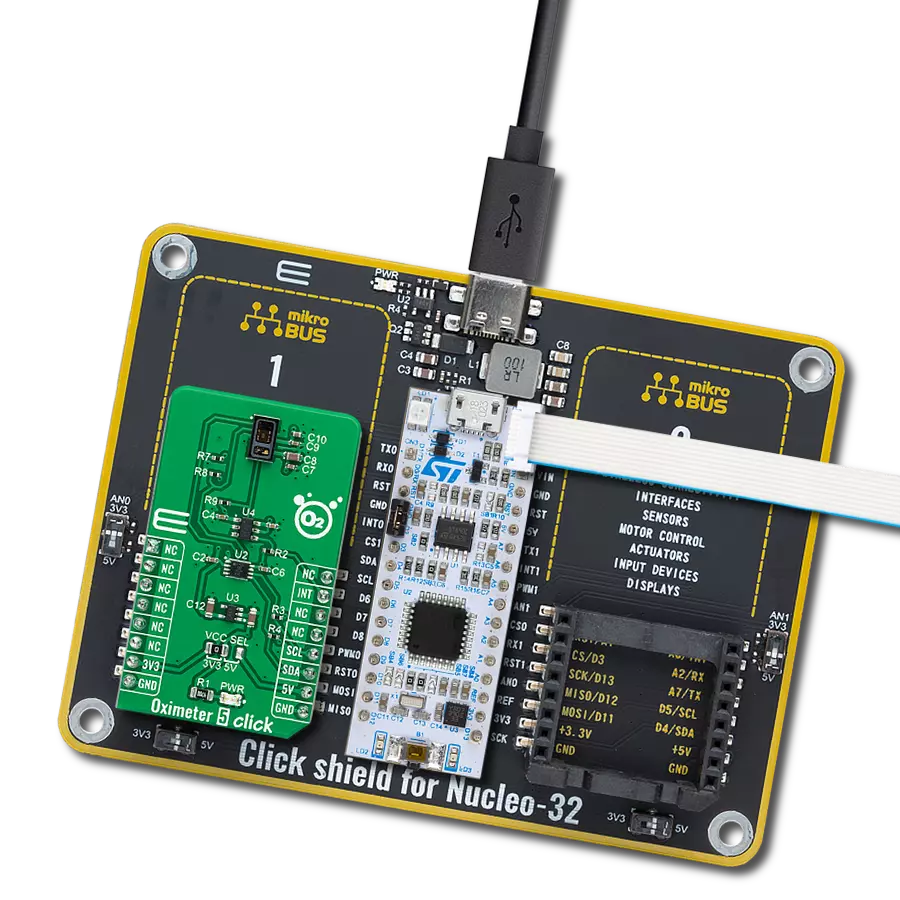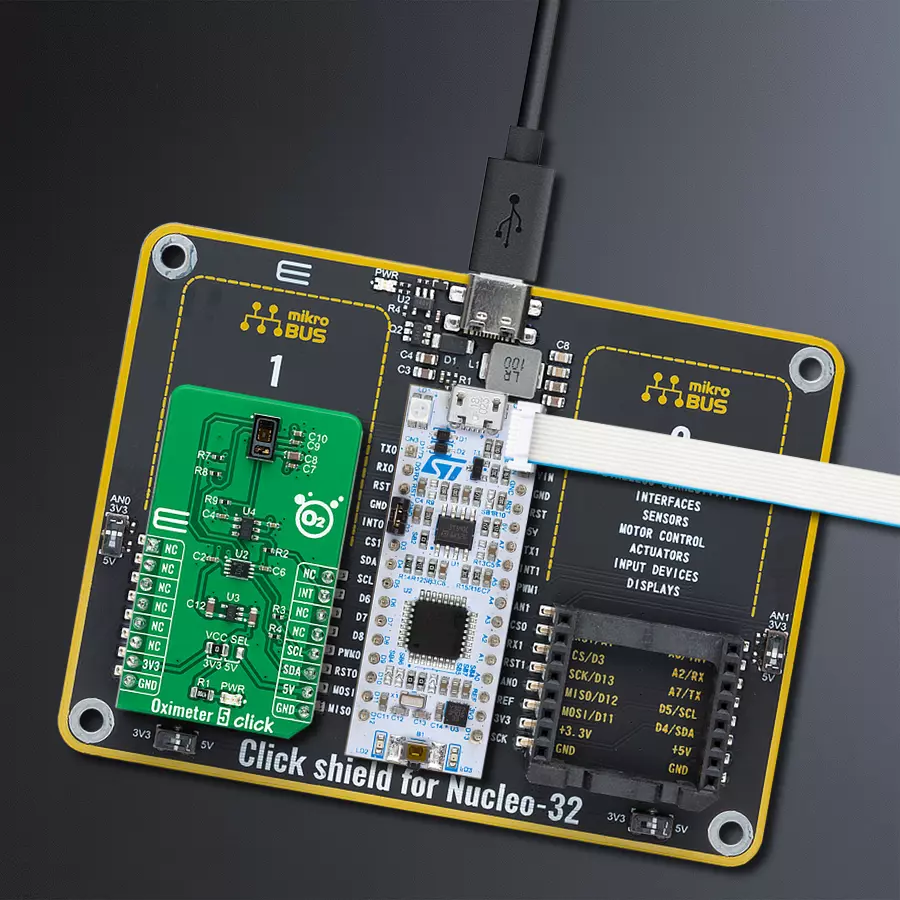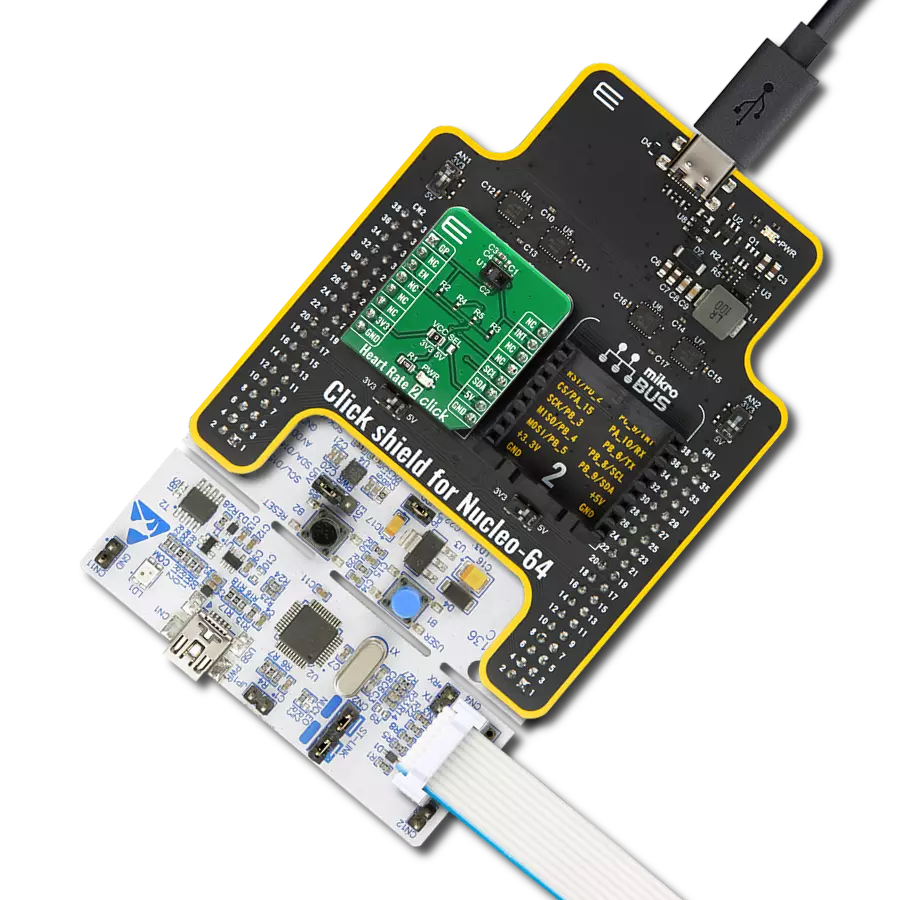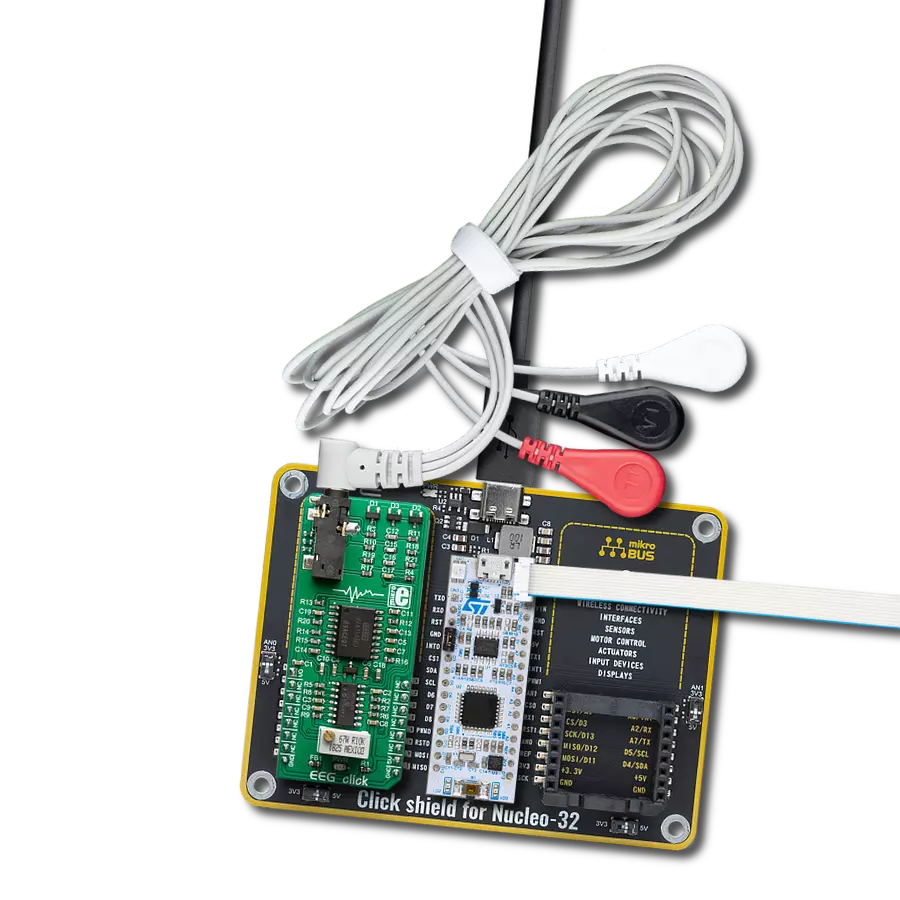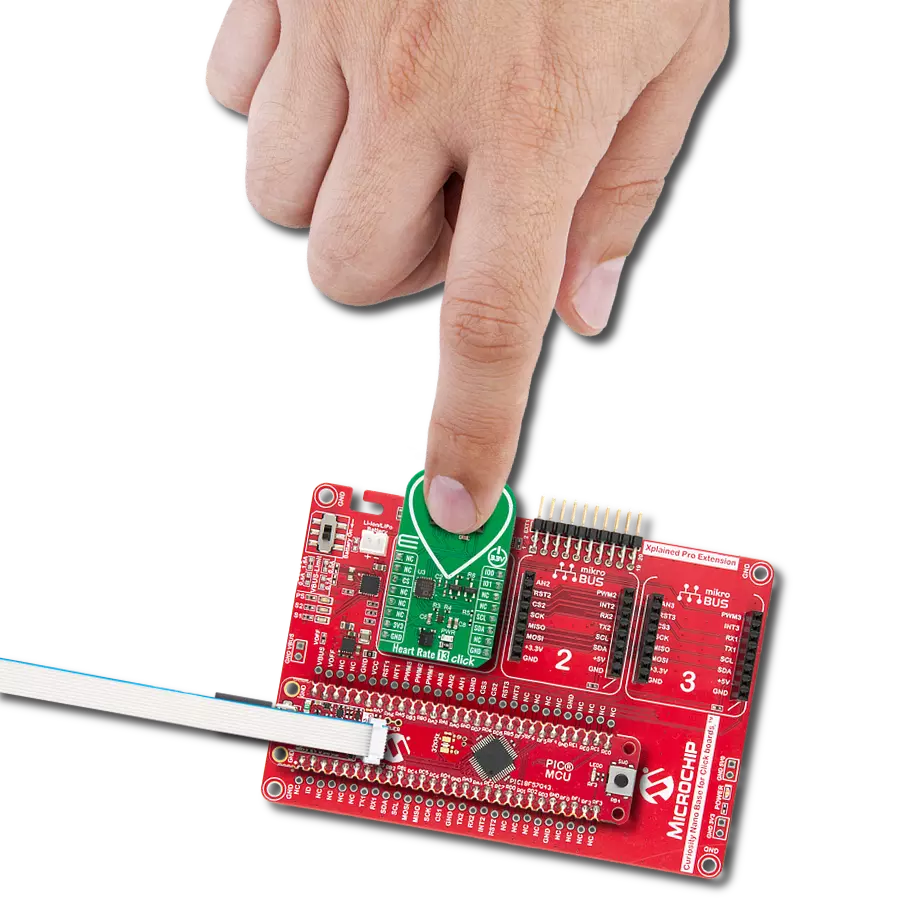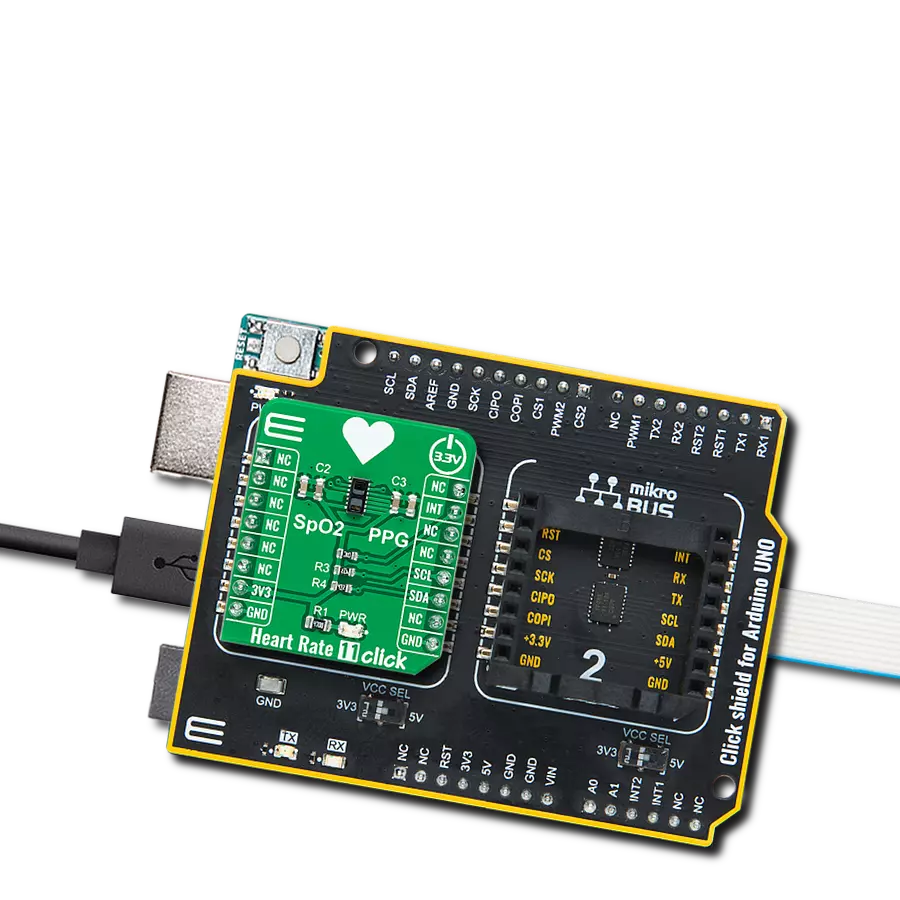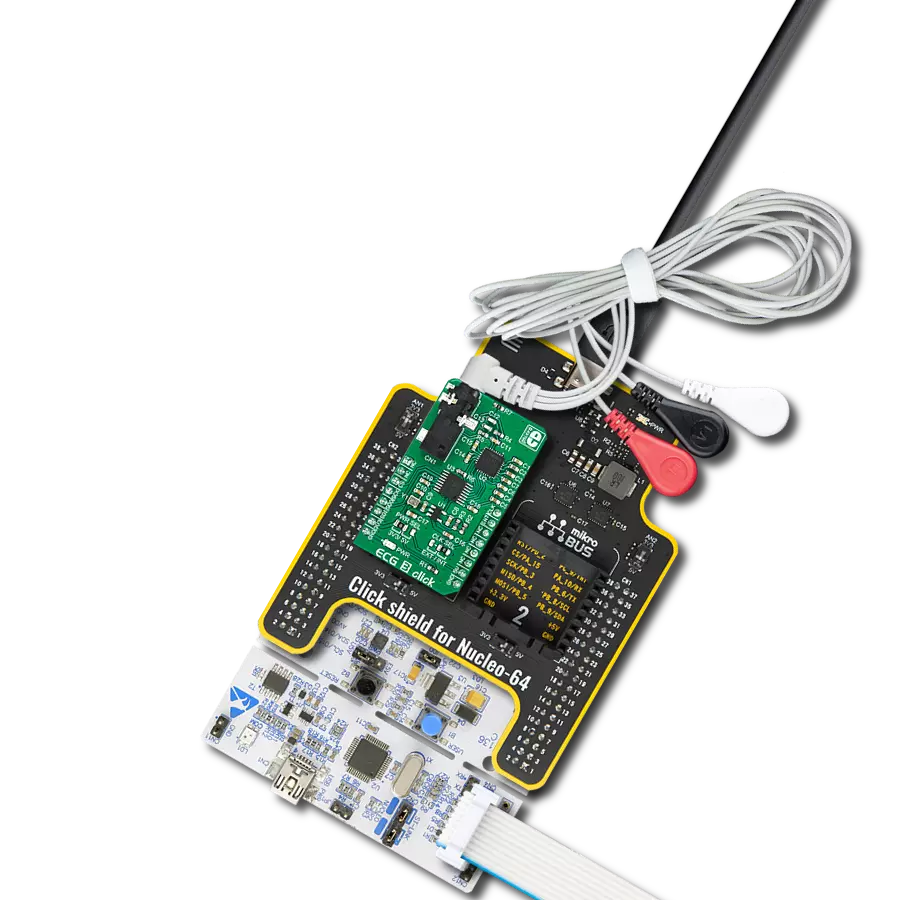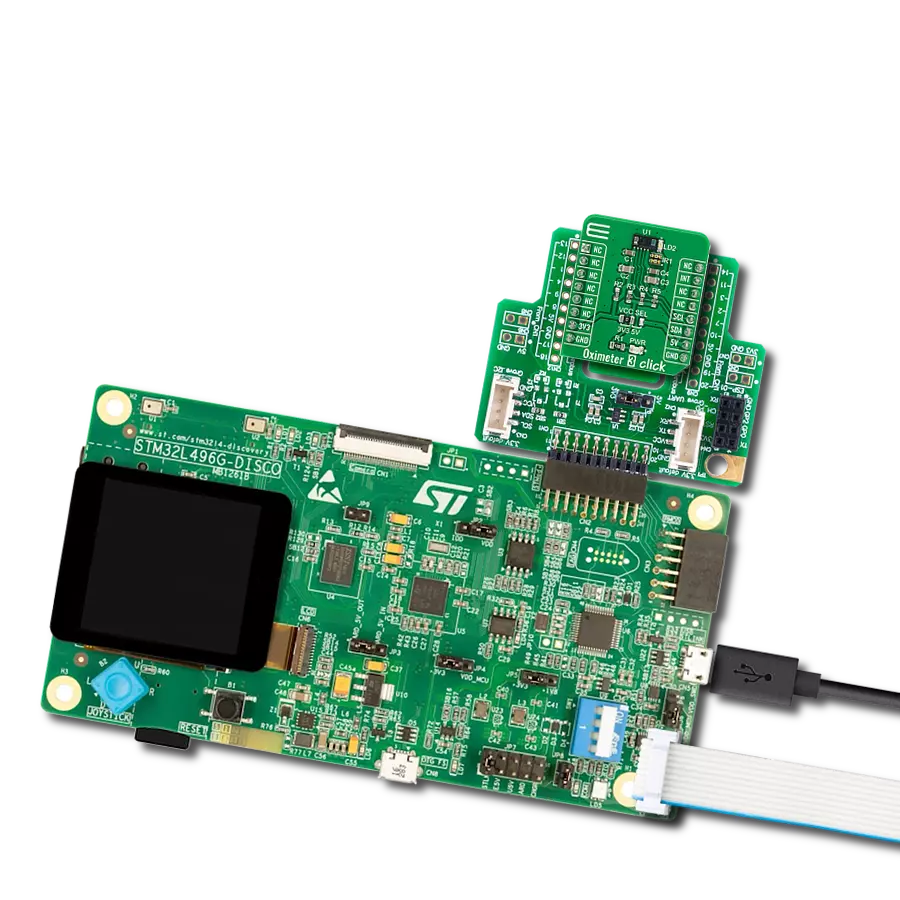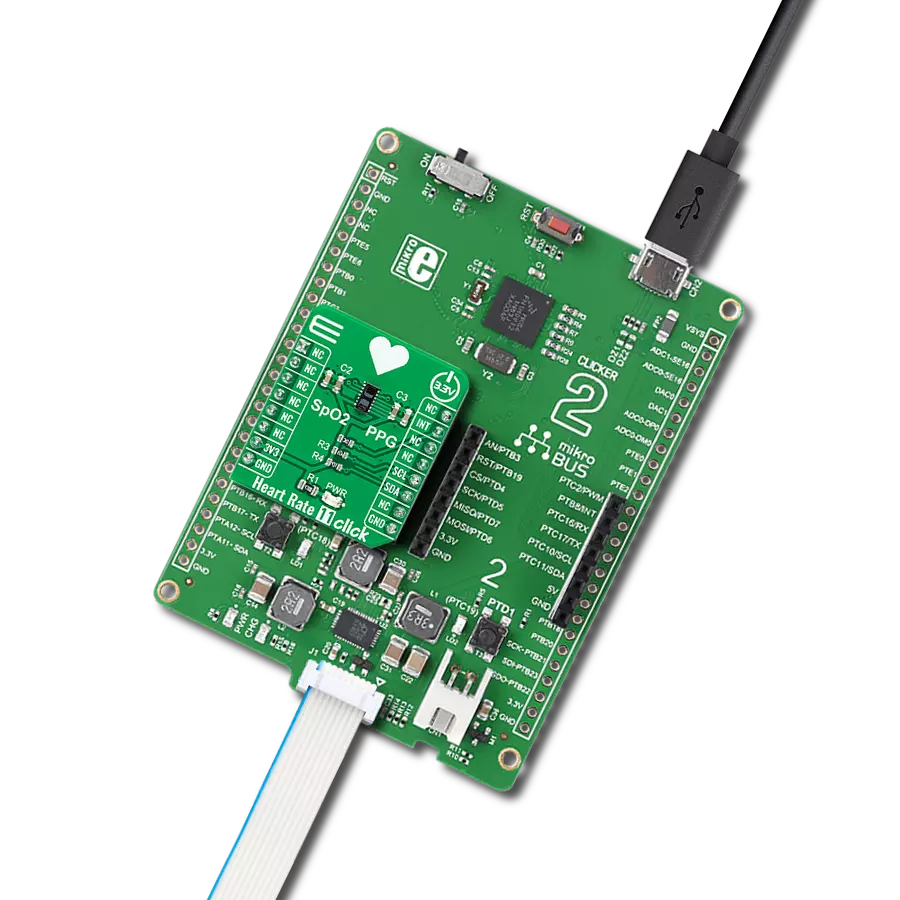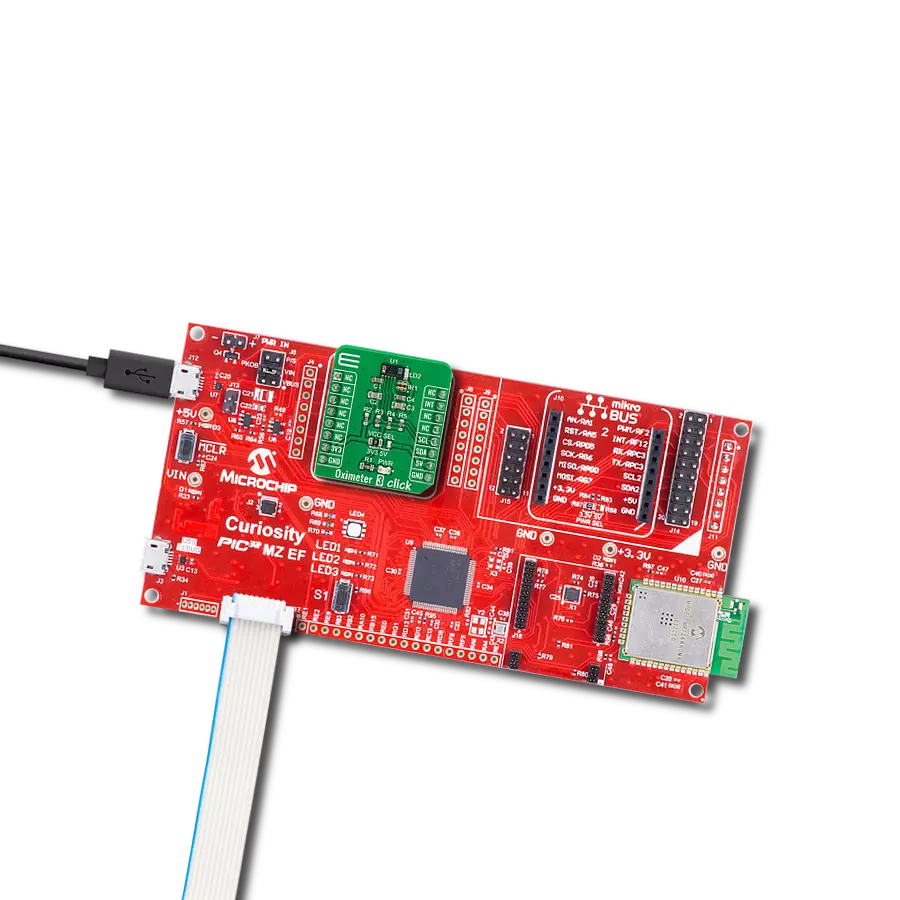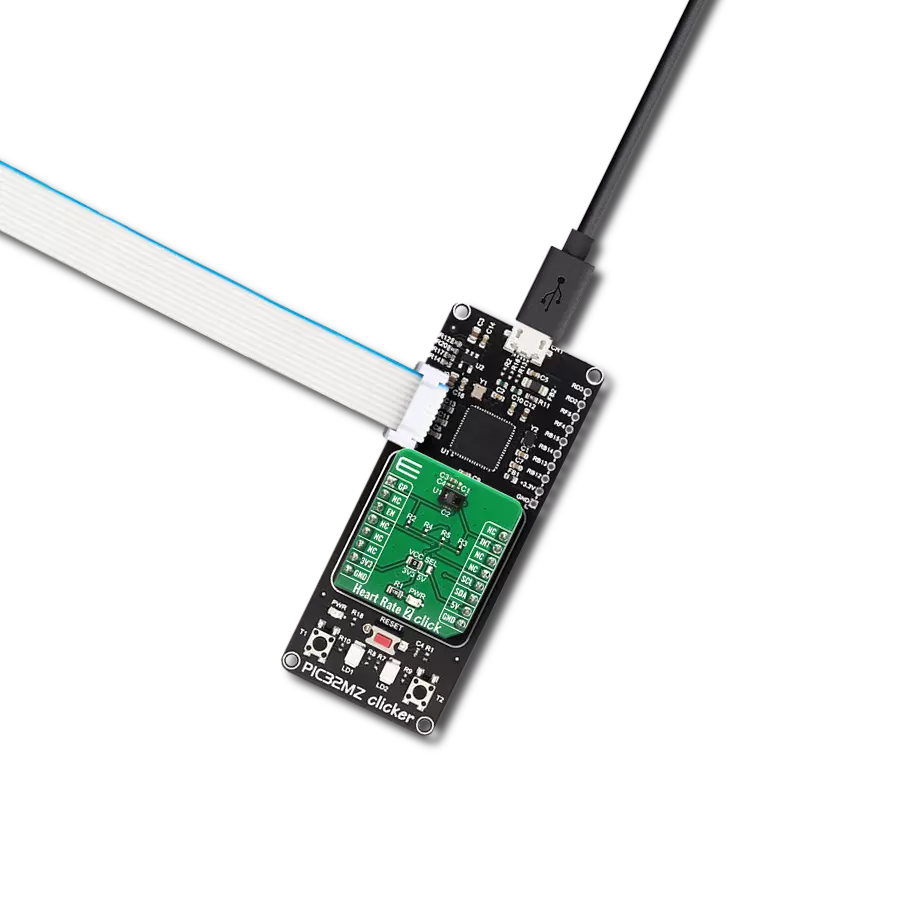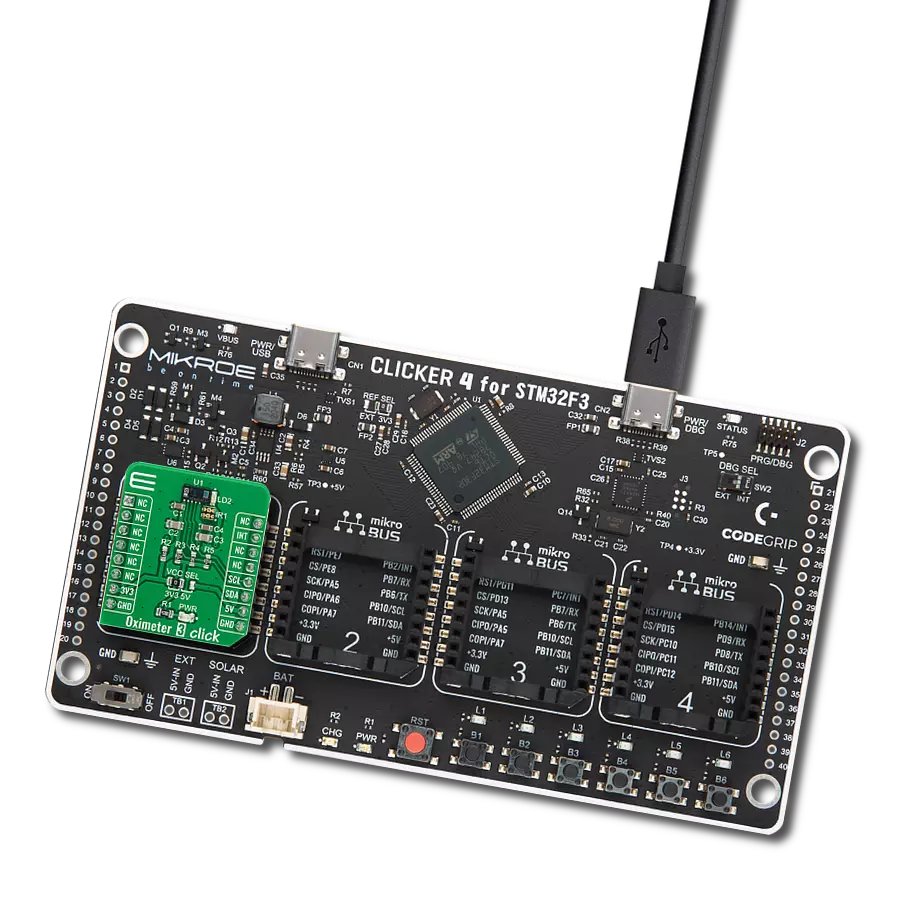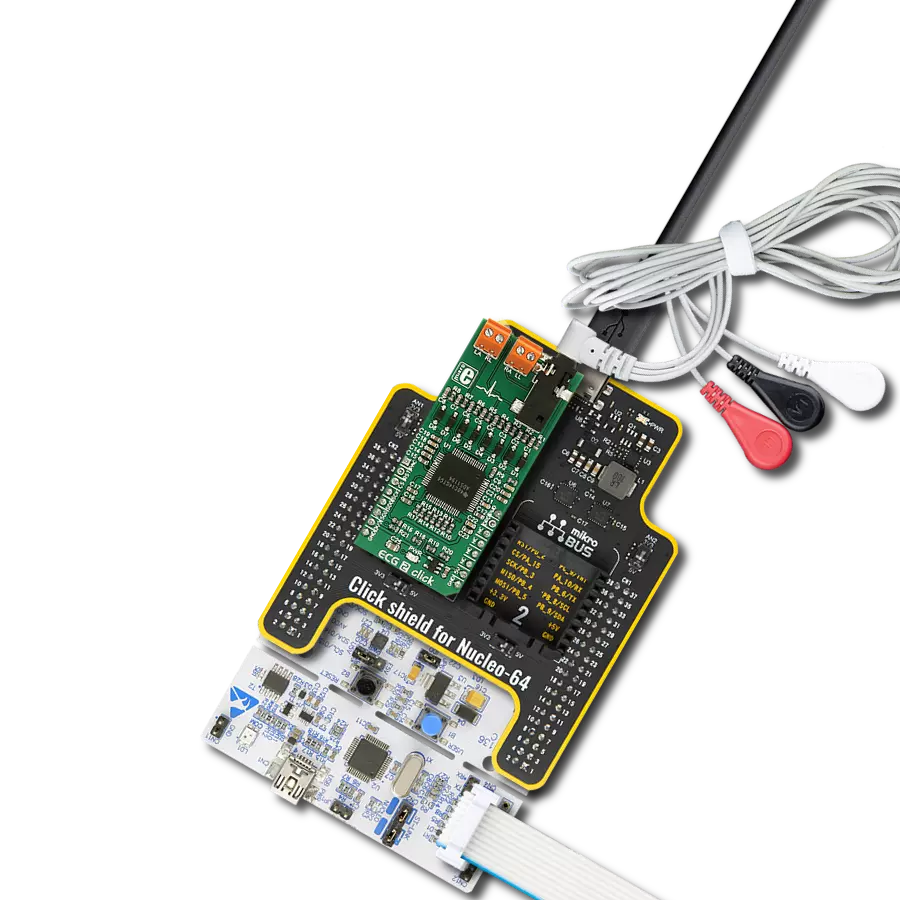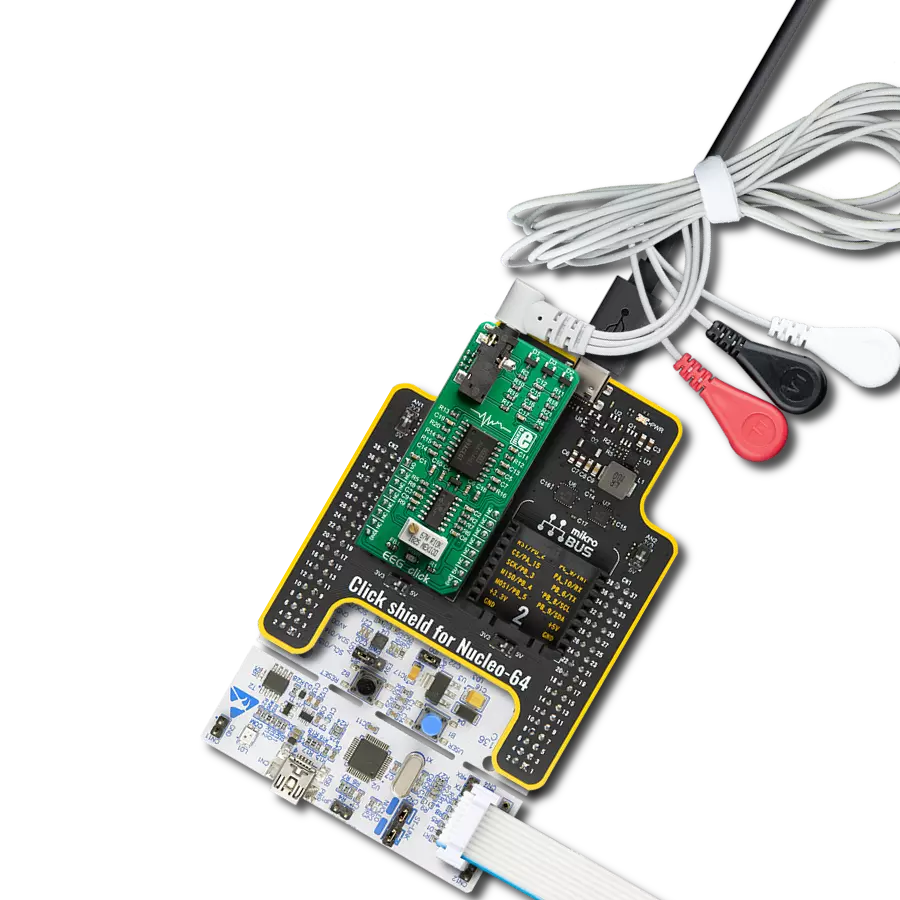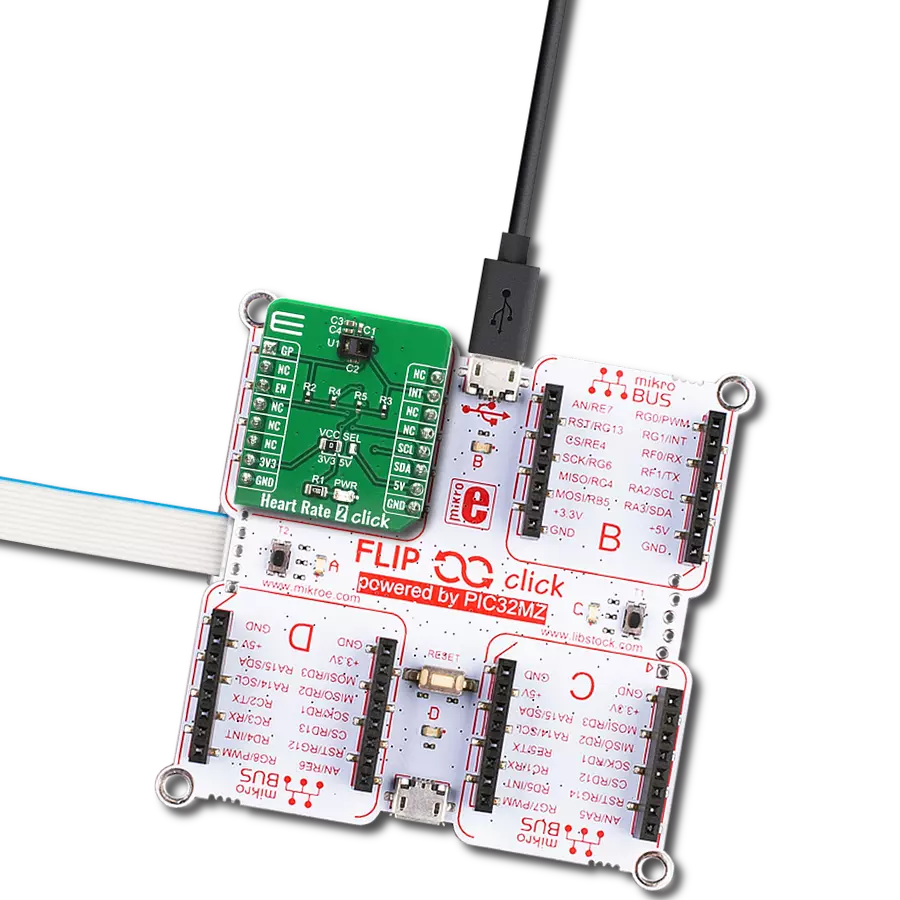Add optical pulse oximetry technology to your solution, enabling accurate and reliable blood oxygen saturation levels monitoring
A
A
Hardware Overview
How does it work?
Oximeter 5 Click is based on the MAX30102, a high-sensitivity pulse oximeter and heart-rate sensor from Maxim Integrated, now part of Analog Devices. The MAX30102 integrates Red and IR LEDs, with 660nm red and 880nm IR wavelengths, to modulate LED pulses for oxygen saturation (SpO2) and heart rate measurements. The LED pulse width can be programmed to allow the algorithm to optimize SpO2 and HR accuracy and power consumption based on use cases. The SpO2 subsystem of the MAX30102 contains ambient light cancellation (ALC), a continuous-time oversampling sigma-delta ADC with 18-bit resolution, and a proprietary discrete-time filter. The ALC has an internal Track/Hold circuit to cancel ambient light and increase the effective dynamic
range. The MAX30102 also has an on-chip temperature sensor with an inherent resolution of 0.0625°C for calibrating the temperature dependence of the SpO2 subsystem. The MAX30102 does not require a specific Power-Up sequence but requires a supply voltage of 1.8V to work correctly. Therefore, a small regulating LDO is used, the MAX8511, which provides a 1.8V out of selected 5V or 3.3V mikroBUS™ power rails. Also, it can be shut down through software with zero standby current, allowing the power rails to remain powered at all times. Oximeter 5 Click communicates with MCU using the standard I2C 2-Wire interface with a maximum clock frequency of 400kHz. It is fully adjustable through software registers, and the digital output data is stored in a 32-deep FIFO within the
device. Since the sensor for operation requires a power supply of 1.8V, this Click board™ also features the PCA9306and SN74LVC1T45voltage-level translators. The I2C interface bus lines are routed to the voltage-level translators allowing this Click board™ to work with both 3.3V and 5V MCUs properly. Also, it uses an interrupt pin, the INT pin of the mikroBUS™ socket, to alert the system that the MAX30102 is ready for operation. This Click board™ can operate with either 3.3V or 5V logic voltage levels selected via the VCC SEL jumper. This way, both 3.3V and 5V capable MCUs can use the communication lines properly. However, the Click board™ comes equipped with a library containing easy-to-use functions and an example code that can be used, as a reference, for further development.
Features overview
Development board
Nucleo 32 with STM32F031K6 MCU board provides an affordable and flexible platform for experimenting with STM32 microcontrollers in 32-pin packages. Featuring Arduino™ Nano connectivity, it allows easy expansion with specialized shields, while being mbed-enabled for seamless integration with online resources. The
board includes an on-board ST-LINK/V2-1 debugger/programmer, supporting USB reenumeration with three interfaces: Virtual Com port, mass storage, and debug port. It offers a flexible power supply through either USB VBUS or an external source. Additionally, it includes three LEDs (LD1 for USB communication, LD2 for power,
and LD3 as a user LED) and a reset push button. The STM32 Nucleo-32 board is supported by various Integrated Development Environments (IDEs) such as IAR™, Keil®, and GCC-based IDEs like AC6 SW4STM32, making it a versatile tool for developers.
Microcontroller Overview
MCU Card / MCU

Architecture
ARM Cortex-M0
MCU Memory (KB)
32
Silicon Vendor
STMicroelectronics
Pin count
32
RAM (Bytes)
4096
You complete me!
Accessories
Click Shield for Nucleo-32 is the perfect way to expand your development board's functionalities with STM32 Nucleo-32 pinout. The Click Shield for Nucleo-32 provides two mikroBUS™ sockets to add any functionality from our ever-growing range of Click boards™. We are fully stocked with everything, from sensors and WiFi transceivers to motor control and audio amplifiers. The Click Shield for Nucleo-32 is compatible with the STM32 Nucleo-32 board, providing an affordable and flexible way for users to try out new ideas and quickly create prototypes with any STM32 microcontrollers, choosing from the various combinations of performance, power consumption, and features. The STM32 Nucleo-32 boards do not require any separate probe as they integrate the ST-LINK/V2-1 debugger/programmer and come with the STM32 comprehensive software HAL library and various packaged software examples. This development platform provides users with an effortless and common way to combine the STM32 Nucleo-32 footprint compatible board with their favorite Click boards™ in their upcoming projects.
Used MCU Pins
mikroBUS™ mapper
Take a closer look
Click board™ Schematic

Step by step
Project assembly
Software Support
Library Description
This library contains API for Oximeter 5 Click driver.
Key functions:
oximeter5_read_sensor_dataOximeter 5 get sensor data function.oximeter5_get_oxygen_saturationOximeter 5 get oxygen saturation function.oximeter5_read_temperatureOximeter 5 read temperature function.
Open Source
Code example
The complete application code and a ready-to-use project are available through the NECTO Studio Package Manager for direct installation in the NECTO Studio. The application code can also be found on the MIKROE GitHub account.
/*!
* @file main.c
* @brief Oximeter5 Click example
*
* # Description
* This library contains API for Oximeter 5 Click driver.
* The demo application reads and calculate
* SpO2 oxygen saturation data.
*
* The demo application is composed of two sections :
*
* ## Application Init
* Initializes I2C driver and log UART.
* After driver initialization the app set
* driver interface setup and default settings,
* buffer length of 100 stores 4 seconds of samples running at 25sps
* read the first 100 samples, and determine the signal range.
*
* ## Application Task
* This is an example that demonstrates the use of the Oximeter 5 Click board™.
* In this example, display the IR and RED ADC data,
* and the SpO2 oxygen saturation data [ 0% - 100% ].
* Results are being sent to the Usart Terminal where you can track their changes.
*
* @note
* A measurement time of at least 10 seconds is required
* for the SpO2 oxygen saturation data to be valid.
*
* @author Nenad Filipovic
*
*/
#include "board.h"
#include "log.h"
#include "oximeter5.h"
static oximeter5_t oximeter5;
static log_t logger;
static uint32_t aun_ir_buffer[ 100 ];
static uint32_t aun_red_buffer[ 100 ];
static uint32_t un_min, un_max, un_prev_data, un_brightness;
static float f_temp;
static uint8_t n_spo2;
void application_init ( void )
{
log_cfg_t log_cfg; /**< Logger config object. */
oximeter5_cfg_t oximeter5_cfg; /**< Click config object. */
/**
* Logger initialization.
* Default baud rate: 115200
* Default log level: LOG_LEVEL_DEBUG
* @note If USB_UART_RX and USB_UART_TX
* are defined as HAL_PIN_NC, you will
* need to define them manually for log to work.
* See @b LOG_MAP_USB_UART macro definition for detailed explanation.
*/
LOG_MAP_USB_UART( log_cfg );
log_init( &logger, &log_cfg );
log_info( &logger, " Application Init " );
// Click initialization.
oximeter5_cfg_setup( &oximeter5_cfg );
OXIMETER5_MAP_MIKROBUS( oximeter5_cfg, MIKROBUS_1 );
if ( I2C_MASTER_ERROR == oximeter5_init( &oximeter5, &oximeter5_cfg ) )
{
log_error( &logger, " Communication init." );
for ( ; ; );
}
Delay_ms ( 100 );
if ( OXIMETER5_ERROR == oximeter5_default_cfg ( &oximeter5 ) )
{
log_error( &logger, " Default configuration." );
for ( ; ; );
}
Delay_ms ( 100 );
un_brightness = 0;
un_min = 0x3FFFF;
un_max = 0;
for ( uint8_t n_cnt = 0; n_cnt < 100; n_cnt++ )
{
while ( oximeter5_check_interrupt( &oximeter5 ) == OXIMETER5_INTERRUPT_ACTIVE );
oximeter5_read_sensor_data( &oximeter5, &aun_red_buffer[ n_cnt ], &aun_ir_buffer[ n_cnt ] );
if ( un_min > aun_red_buffer[ n_cnt ] )
{
un_min = aun_red_buffer[ n_cnt ];
}
if ( un_max < aun_red_buffer[ n_cnt ] )
{
un_max = aun_red_buffer[ n_cnt ];
}
}
oximeter5_get_oxygen_saturation( &aun_ir_buffer[ 0 ], 100, &aun_red_buffer[ 0 ], &n_spo2 );
log_info( &logger, " Application Task " );
Delay_ms ( 100 );
}
void application_task ( void )
{
for ( uint8_t n_cnt = 25; n_cnt < 100; n_cnt++ )
{
aun_red_buffer[ n_cnt - 25 ] = aun_red_buffer[ n_cnt ];
aun_ir_buffer[ n_cnt - 25 ] = aun_ir_buffer[ n_cnt ];
if ( un_min > aun_red_buffer[ n_cnt ] )
{
un_min = aun_red_buffer[ n_cnt ];
}
if ( un_max < aun_red_buffer[ n_cnt ] )
{
un_max=aun_red_buffer[n_cnt];
}
}
for ( uint8_t n_cnt = 75; n_cnt < 100; n_cnt++ )
{
un_prev_data = aun_red_buffer[ n_cnt - 1 ];
while ( oximeter5_check_interrupt( &oximeter5 ) == OXIMETER5_INTERRUPT_ACTIVE );
oximeter5_read_sensor_data( &oximeter5, &aun_red_buffer[ n_cnt ], &aun_ir_buffer[ n_cnt ] );
if ( aun_red_buffer[ n_cnt ] > un_prev_data )
{
f_temp = aun_red_buffer[ n_cnt ]-un_prev_data;
f_temp /= ( un_max - un_min );
f_temp *= MAX_BRIGHTNESS;
f_temp = un_brightness - f_temp;
if ( f_temp < 0 )
{
un_brightness = 0;
}
else
{
un_brightness = ( uint32_t ) f_temp;
}
}
else
{
f_temp = un_prev_data - aun_red_buffer[ n_cnt ];
f_temp /= ( un_max - un_min );
f_temp *= MAX_BRIGHTNESS;
un_brightness += ( uint32_t ) f_temp;
if ( un_brightness > MAX_BRIGHTNESS )
{
un_brightness = MAX_BRIGHTNESS;
}
}
if ( ( OXIMETER5_OK == oximeter5_get_oxygen_saturation( &aun_ir_buffer[ 0 ], 100, &aun_red_buffer[ 0 ], &n_spo2 ) ) )
{
if ( aun_ir_buffer[n_cnt] > 10000 )
{
log_printf( &logger, "\tIR : %lu \r\n", aun_ir_buffer[ n_cnt ] );
log_printf( &logger, "\tRED : %lu \r\n", aun_red_buffer[ n_cnt ] );
log_printf( &logger, "- - - - - - - - - - - - - - -\r\n" );
log_printf( &logger, "\tSPO2 : %d %%\r\n", ( uint16_t ) n_spo2 );
log_printf( &logger, "-----------------------------\r\n" );
Delay_ms ( 100 );
}
else
{
Delay_ms ( 10 );
}
}
}
}
int main ( void )
{
/* Do not remove this line or clock might not be set correctly. */
#ifdef PREINIT_SUPPORTED
preinit();
#endif
application_init( );
for ( ; ; )
{
application_task( );
}
return 0;
}
// ------------------------------------------------------------------------ END
Additional Support
Resources
Category:Biometrics
